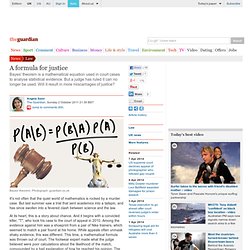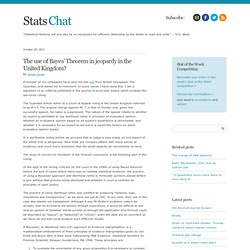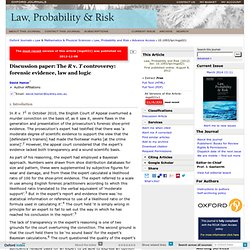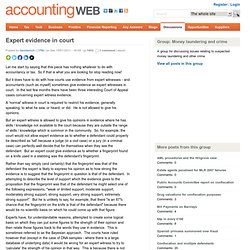

A formula for justice. It's not often that the quiet world of mathematics is rocked by a murder case.

But last summer saw a trial that sent academics into a tailspin, and has since swollen into a fevered clash between science and the law. At its heart, this is a story about chance. And it begins with a convicted killer, "T", who took his case to the court of appeal in 2010. Among the evidence against him was a shoeprint from a pair of Nike trainers, which seemed to match a pair found at his home. While appeals often unmask shaky evidence, this was different. But more importantly, as far as mathematicians are concerned, the judge also ruled against using similar statistical analysis in the courts in future.
"The impact will be quite shattering," says Professor Norman Fenton, a mathematician at Queen Mary, University of London. Specifically, he means a statistical tool called Bayes' theorem. The data needed to run these kinds of calculations, though, isn't always available. Kaye.authcheckdam. The use of Bayes’ Theorem in jeopardy in the United Kingdom? A number of my colleagues have sent me this link from British newspaper The Guardian, and asked me to comment.

In some sense I have done this. I am a signatory to an editorial published in the journal Science and Justice which protests the law lords’ ruling. The Guardian article refers to a Court of Appeal ruling in the United Kingdom referred to as R v T. The original charge against Mr. T. is that of murder and, given the successful appeal, his name is suppressed.
It is worthwhile noting before we proceed that to judge a case solely on one aspect of the whole trial is dangerous. Extending the Confusion About Bayes - Robertson - 2011 - The Modern Law Review. R v T: Bibliography of responses and ensuing discussion. Discussion paper: The R v. T controversy: forensic evidence, law and logic. In R v.

T1 in October 2010, the English Court of Appeal overturned a murder conviction on the basis of, as it saw it, severe flaws in the generation and presentation of the prosecution’s forensic shoe-print evidence. The prosecution’s expert had testified that there was ‘a moderate degree of scientific evidence to support the view that the [defendant’s trainers] had made the footwear marks [at the crime scene]’.2 However, the appeal court considered that the expert’s evidence lacked both transparency and a sound scientific basis. As part of his reasoning, the expert had employed a Bayesian approach. Numbers were drawn from shoe distribution databases for size and pattern, these were supplemented by subjective figures for wear and damage, and from these the expert calculated a likelihood ratio of 100 for the shoe-print evidence.
Expert evidence in court. Let me start by saying that this piece has nothing whatever to do with accountancy or tax.

So if that is what you are looking for stop reading now! But it does have to do with how courts use evidence from expert witnesses - and accountants (such as myself) sometimes give evidence as expert witnesses in court. In the last few months there have been three interesting Court of Appeal cases concerning expert witness evidence. A 'normal' witness in court is required to restrict his evidence, generally speaking, to what he saw, or heard, or did. He is not allowed to give his opinions. Criminal Solicitor Dot Net : R v T Admissibility of forensic evidence. Forensic Science: R v T [2010] EWCA Crim 2439. Fenton & Neil 2012. Abertay Research Collections: Forensic science evidence in question.
4aSCa2%20Morrison%20-%20R%20v%20T. R. v. T [2010] All ER (D) 240 (Oct); [2010] EWCA Crim 2439. In R. v. T [2010] All ER (D) 240 (Oct), judgment delivered October 26, 2010, the Court of Appeal, Criminal Division, held that, in the area of footwear evidence, no attempt could realistically be made in the generality of cases to use a formula to calculate the probabilities. That practice had no sound basis and it was clear from settled law that outside the field of DNA, Bayes theorem and likelihood ratios should not be used.